Brief Introduction to Spectacles
Frames
The part of the spectacles that holds the lens in front of the eye is called the frame. This usually rests on the bridge of the nose and the ears. Frames are available in a variety of shapes, structures, materials and colors. The frame that one chooses can affect the comfort, vision and appearance of the spectacles and its wearer. Thus it is important to guide the customer to choose one most apt to his physical features and his habits. This section deals in depth with the parts of a frame and types of frames – based on different designs and materials. It also discusses what features are desirable for a spectacle frame.
Parts of a frame
The basic parts of a spectacle frame are Fig 3.1,Fig. 3.1a:

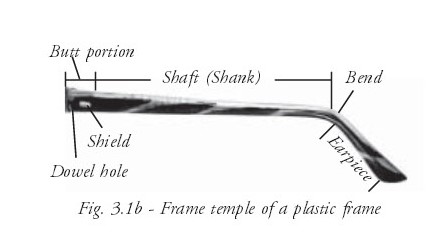
-
- Skull temple: This is the most common type
of temple. The skull temple is most
comfortable for those people who wear their
eyeglasses for long periods of time. It fits easily
on the ear, and bends slightly to fit the skull
and lightly hug the head Fig 3.2a, Fig. 3.2b.
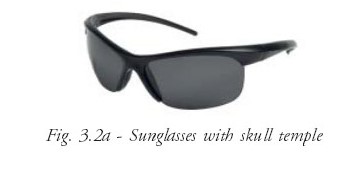
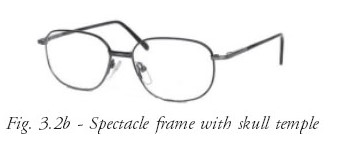
-
- Library temple: The temple is a straight line
with rarely a slight bend at the very tip. It is
suitable for those who need to remove their
spectacles many times a day as in reading
glasses Fig 3.3a.


-
- Riding bow/Cable temple: This temple has
a curved earpiece and fits around the ear. It
hugs the ear, and is more difficult to remove.
This type of temple would be particularly
helpful for those people whose jobs are very
active, or for children Fig 3.3b.
-
- Convertible temple: This looks like a straight
line without bend. It can be converted from
one shape to another. It can be bent to any
shape for comfort Fig. 3.3c.

Today, many fancy and minimalist designs are available. When the temple is made of memory metals which are flexible, there is no hinge at all. Spring hinges use a spring tension to press the temples of the frame closer to the sides of the head. This allows for a closer, snugger fit. As a result, models with spring hinges are usually more expensive.


Frame measurements
Most frames have the following measurements printed on them (usually on the inner surface of the temple) (Fig. 3.6):

Frame designs
Metal and shell frames are usually different in their design especially with respect to the nose pads. Metal
frame has plastic or rubber sleeves at the earpiece to avoid skin contact with metal; this is not necessary in plastic frames. Combined frames or combination frames are contemporary frames which have a metal front with plastic sides or plastic fronts with metal
sides.
More recently frames are available in very
different and fancy shapes to meet the local and current
trends as well as specific functionality such as sports
eyewear.


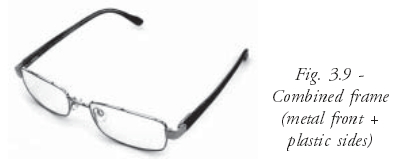
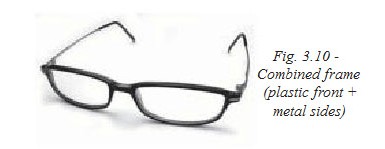
Rimless frames are frames without eye wires. The lenses are held in place by screws running through holes drilled into the lenses. Half-rimless or semi- rimless frames have eye wire only along a part of the lens – along the top or along the bottom of the lens or either at the templar or nasal regions. Here, the lens has a groove running along its edge carrying a nylon wire which fixes the lens in position in the frame. Almost all frame models are available in both metal and plastic materials. Half eye frames are designed for reading as it rests lower on the nose. Sports and protection eyewear are made of impact resistant material and are designed for a snug fit.
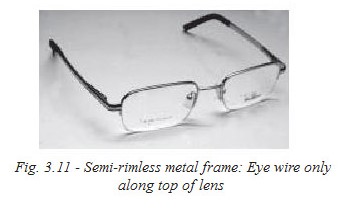
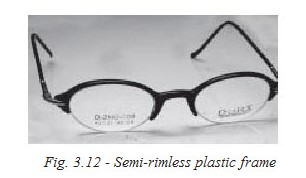
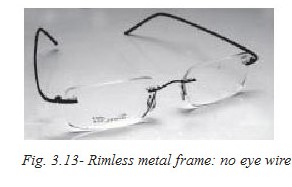
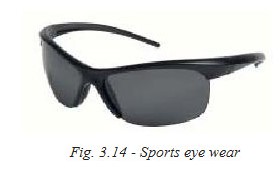
Frame materials
Desirable qualities of a spectacle frame are:
- Durability – the frame must be able to withstand wear and tear
- Light-weight – if the frame is too heavy it is uncomfortable for prolonged use and can also cause marks on the wearer’s face
- Flexible – the frame must be flexible enough to be easily adjusted, to insert the lens and to withstand different conditions and handling
- Maintain the original shape
- Fast Color – The coloring on the frame must not fade, peel or wash off
- Inert to body fluids – frame material must not react to common body secretions like sweat and sebum. It should not cause any skin allergy.
- Inexpensive Another look at the above features will show that some of these are contradictory. For instance, it insist that a frame must be tough - to maintain its original shape - yet we also require it to be flexible; it requires that the frame material should react well with the coloring agents but not react with body fluids. Thus very few frame materials can satisfy all these qualities. However, many materials today can be used to make a comfortable, affordable, durable, good-looking frame. Basically frame materials can be classified as Plastics and Metals.
Plastic frames
Plastic frames have some drawbacks: They are easier to break than metal frames, they can burn (but are
not easily ignited), and aging and exposure to sunlight slightly decrease their strength but do not affect color.
These frames are sometimes referred to as “shell" frames because the first frames were made from
Tortoise shell. This material was soon banned as it threatened the survival of this species.
Plastic frames are manufactured by the following methods:
- Injection molding: The melted plastic is injected into frame-shaped moulds and cooled to get the shape of the frame. Fronts and temples are made in this way and polished. Metal joints are usually fixed prior to cooling.
- Routing or machining: Here the frame shape is cut out of a sheet of plastic by means of a die and it is polished. The metal joints are heat-inserted or riveted.
Thermosetting
- This type of plastic is not flexible
- This hardens after final adjustment
- If heated, it burns or melts
- Used for readymade spectacles, sunglasses etc.,where adjustment or fitting cannot be done
- Not suitable for spectacle dispensing
Thermoplastic
- This kind of plastic is more flexible and adjustable
- Can be reformed with heat
- Flexible
- Can be reused
- Suitable for spectacle dispensing
The following are the plastic materials used in frame manufacture:
Cellulose acetate
Used since 1894, it is made from cotton linters and acetic acid. These frames are made by machining - joints are heat inserted or riveted and colour is applied by lamination. These frames are lightweight and stable at room temperature. They are non-flammable (softens at 57°C) – making them easy to adjust by warming. But the acetate is not resistant to common solvents and so it is allergenic: the frames whiten at the bridge and temple where there is prolonged contact with skin
Cellulose nitrate
Made from cotton linters and nitric acid with camphor. This material is stronger than acetate – but it becomes brittle. It is a thermosetting plastic. This softens at 65°C but it gets inflamed at 70°C. So it has been banned in countries like UK. In India it is still used to make cheap frames. This frame cannot be reused.
Cellulose propionate
Some manufacturers also use propionate - a nylon- based plastic that is hypoallergenic. It is lightweight.
Optyl
This material is an epoxy resin which softens at 80°C.It is 30% lighter than acetate. It is produced by moulding and colour is added by dying and varnishing. This material has “thermoplastic memory" – this is the ability of the material to regain its original shape however it is bent.
Polymethylmethacrylate
It is rarely used as frame material as it is hard, rigid and brittle when adjusted. It is a stable and lightweight material which can be coloured by lamination. It is also hypoallergenic (does not cause allergy). It is sometimes used for rigid frame parts as in nose piece and temples for plastic rimless frames.
Nylon
First introduced in the 1940s. As this was brittle,frames are now manufactured with blended nylon which is both strong and lightweight.
Carbon fiber
Carbon frames have 20% carbon fiber and 80% nylon. This material is made by weaving carbon fibers and nylon together. The carbon gives the frame a dark grey colour. This can be coloured by lacquer.This material is thin and very strong but it is not very adjustable. This material is usually used only for the frame front and the sides are usually of another material – usually metal. These sides are attached by a screw fitting to the front. These frames cannot be reused.
Polycarbonate
These frames are used for sports eyewear or safety glasses, nonprescription shields- where the lenses and frame are molded in one unit. Used in combination with polycarbonate lenses, this material offers best impact resistance and eye protection. This material can not be adjusted very well and so cannot be used for spectacle frames.
Metal frames
The following metals are used in frame manufacture:
Nickel silver
It is an alloy of copper, zinc and nickel (12 - 25%).It is a relatively flexible material but it is hyper allergenic and turns green with prolonged contact with body fluids. It needs plating to prevent discolouring.
Monel
It has been used since 1905. It has higher nickel content than nickel silver. Its constituency is 66% nickel; 31.5% copper and traces of iron, manganese & silicon. It is malleable and corrosion-resistant - especially if the right kind of plating, such as palladium or other nickel-free options is used. Otherwise, due to the high nickel content, there is a higher risk of allergic reaction. It is usually used for eye wire with a memory metal bridge so it does not come in contact with the skin. It is the most widely used material in manufacture of frames
Titanium
Titanium is one of the ideal metals for frames but extraction and manufacture costs make it expensive. It is used as an alloy of titanium, vanadium,aluminum and manganese, called ß (beta) Titanium. It is only half the weight of nickel silver. Its surface hardness is 3 times that of gold plating making it resistant to scratches. Titanium is very flexible - 20% more elastic than nickel silver. Welding of titanium and its alloys can be easily performed, but it is expensive. It is hypo-allergenic, in its pure form, but is usually adulterated with Nickel.
Memory metals
Developed initially for the US military in 1961, these are alloys – usually 40% nickel and 60% titanium or cobalt and titanium. These are very flexible – they are capable of retaining their original shape – so it is called “memory metal". But this makes it difficult to adjust. The flexibility of this alloy is eight times that of spring steel. It is resistant to corrosion and commonly used for bridges and sides which need not be adjusted
Aluminum
Aluminum is very light and can be coloured by anodizing and dying. It is hypoallergenic and resistant to stain and tarnish. But it is unsuitable for frames as it cannot be soldered or brazed and joints have to be pinned. However it can be used for sides.
Stainless steel
It is an alloy of iron, chromium and rarely nickel. It is strong, lightweight and when it is nickel-free, hypoallergenic. It is easy to adjust, not easily damaged and rarely causes skin irritation. It discolours when heated.
Beryllium
This is a low-cost alternative to titanium eyewear. It resists corrosion and tarnish, making it hypoallergenic. It is also lightweight, very strong and
very flexible - making it easy to adjust.
Metal frames always undergo a special process called electroplating for a final finish. This process coats the base material with a plating material like
gold, palladium, rhodium and ruthenium and chromium. This plating is protected from sweat by lacquer which can be applied as a liquid or as a powder,
which is then heated until it liquefies. Metallic finish can also be given by ‘powder coating’ where the surface
metal is made into fine powder and sprayed onto the frame; this is then heated till the powder melts and coats the frame evenly
Frames are also available in other less common materials. These are very expensive.
- Silver: Silver is sometimes used as a trace element in metal alloy frames – and for decoration.
- Gold: Gold is typically used as plating and as decoration. Gold frames are sometimes made with 18K gold. It is seldom used as it is a soft material
- Wood and Bone: These are stiff and not flexible.They tend to break when adjusted. Thus they are rarely used except as a fancy item making them much more expensive
- Leather: This is not as durable or practical as other materials but it provides a fashionable look.
- Semi-precious or precious stones:These are sometimes used as decoration in frames, especially in the temples. Popular choices are onyx and turquoise, but even diamonds can be used.
Optics
Optics is the study of light. Light helps one to see.
Some metals and their use in frame manufacture:
| Metals | Front | Side | Rim | Bridge | Joint | Pad Arm |
Decor | Surface Finish |
Core |
| Chromium | ✔ | ||||||||
| Copper | ✔ | ||||||||
| Gold | ✔ | ✔ | ✔ | ✔ | |||||
| Nickel | ✔ | ✔ | ✔ | ✔ | |||||
| Palladium | ✔ | ||||||||
| Ruthenium | ✔ | ||||||||
| Rhodium | ✔ | ✔ | |||||||
| Aluminum | ✔ | ✔ | ✔ | ✔ | |||||
| Titanium | ✔ | ✔ | ✔ | ✔ | ✔ | ✔ | |||
| Bronze | ✔ | ✔ | |||||||
| Nickel Copper | ✔ | ✔ | ✔ | ✔ | ✔ | ||||
| Monel | ✔ | ✔ | ✔ | ||||||
| Beryllium Copper | ✔ | ✔ | |||||||
| Nickel Manganese | ✔ | ||||||||
| Stainless Steel | ✔ | ✔ | ✔ | ✔ | ✔ | ✔ | ✔ |
Properties of light
Light travels in a straight line
Light travelling in a straight line represents a ray of light. A set of straight lines represent a beam of light.The beam may be parallel, converging or diverging.
The branch of optics based on this property of light is known as Geometrical Optics.
Light gets reflected
When the light traveling in a medium is incident on another medium, part of the light is sent back into the first medium. This is reflection. The surface separating the two media is the reflecting surface.Sometimes this surface is coated (silvered) to increase reflection. When the surface is smooth and polished it is a regular reflection giving rise to an image. Irregular reflection (scattering) occurs when the surface is not smooth.
Laws of reflection
First Law: The incident ray, the reflected ray and the normal ray at the point of incidence on the reflecting surface are all in the same plane (Fig. 3.15).
Second Law:The angle of incidence is equal to the angle of reflection.
The most important application of reflection is in the plane mirror. The use of such mirrors for cosmetics
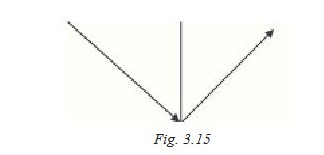
is well known. The image formed on a plane mirror is virtual (not real). It is of the same size as the object and is formed as far behind the mirror as the object is in front of it. The image has left / right inversion.
Plane mirror is used in refraction cubicles to reduce the length of the cubicle to half its length.However the Snellen’s chart used with plane mirror will have objects with left right inversion so the patient sees the correct image inside the mirror.
Light gets refracted
When light travelling in one medium enters another there is deviation (bending) in its path. This is known as refraction which arises because of differences in the speed of light in different media.
Laws of refraction
First Law:The incident ray, the reflected ray and the normal ray at the point of incidence on the refracting surface are in the same plane (Fig. 3.16).
Second Law:The ratio of the sine of the angle of incidence to the sine of angle of refraction is a constant which is known as the refractive index of
the second medium with respect to the first medium.
(sin i / sin r = constant).
Refractive index (μ)
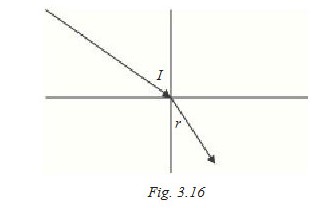
It is the ratio of speed of light in air to the speed of light in the medium. The speed of light in air is maximum (180,000 m/s). Hence the refractive index of a medium is always greater than 1.
For air µ= 1, for water µ= 1.33, for glass µ= 1.5
Prisms and lenses used in ophthalmic practices are refraction devices.
It refers to how much the material is capable of bending the ray of light. A lens with a low refractive index can bend the ray substantially only when it is much thicker than a material of higher refractive index, which can deflect the ray of light even if it is a very thin lens. (Symbol: µ).
Abbé value
Dispersion is the amount different wavelengths of light that the lens spreads out. Abbé number, also called constringence or v value is its reciprocal. Decreasing the Abbé number (or increasing the dispersion) always makes the optical performance poorer – this is experienced as more chromatic aberrations and glares. Usually, an increase in the refractive index decreases the Abbé value – thus it is recommended that hi-index lenses be dispensed with anti-reflective coatings.
Prisms
A prism is a transparent triangular piece of glass or plastic. It has with two plane (flat) refracting sides,an apex (top) and a base (bottom) (Fig. 3.17). A ray
of light incident to a prism is always bent towards the base of the prism. The image formed appears displaced towards its apex.
Prisms are used to measure and also to correct muscular imbalance in patient’s eyes.
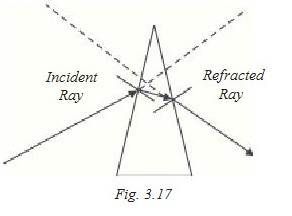
Prism diopter
Prism power is measured by the extent of deviation produced as a light passes through it. If the displacement of the image of an object located 100 cm away from the prism is x cm when seen through the prism its power is xUD (prism diopter) (Fig.3.18).

Lens
A lens is a transparent medium bounded by two curved surfaces or one curved surface and a plane surface. Its
most common application correction of refractive errors of the eye.
Lenses can be of six different types (Fig. 3.19)
- Biconvex lens - both sides are convex
- Plano-convex lens - one side is plane, the other side is convex
- Meniscus lens - convex meniscus: meniscus shaped with greater convex curvature
- Biconcave lens - both sides are concave
- Plano-concave lens - one side is plane and other side is concave
- Meniscus lens - concave meniscus: meniscus with greater concave curvature
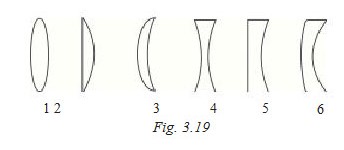
To understand the working of lenses consider two prisms placed base to base. Light rays through them coverage (come together) at some point on the other side of the prism. Similarly if two prisms are placed together apex to apex, the ray will diverge (spread apart) on the other side of the prism (Fig.3.20).
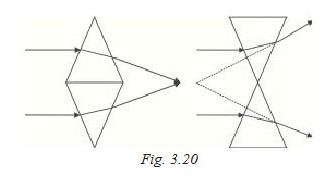
In most applications the curved surface lenses are spherical (part of a sphere) and such lenses are called spherical lenses.
Lenses that converge a beam of light are known as converging, convex or positive lenses while those that diverge a beam of light are known as diverging, concave or negative lenses.
Some important terms relating to lenses
Optic centre: It is a point on a lens where a ray of light passing through it goes straight (there is no deviation).
Principal axis: It is the line joining the centres of curvature of the two curved sides of the lens. In case of plano-convex or plano-concave lenses it is perpendicular to the flat surface from the centre of curvature of the other curved surface.
Focal point (Principal focus): A beam of light parallel to the principal axis of a lens after refraction converges towards a point on the principal axis (convex lens) or appears to diverge from a point on the principal axis (concave lens). This is called the focal point. There are two focal points on either side of a lens at equal distances from the optic centre.
Focal length: The distance of the focal point from the optic centre is the focal length (f ).
Power of a lens: The reciprocal of the focal length measured in metre units is the power of the lens in diopter (D = 1 / f ). It is taken as positive for convex lenses and negative for concave lenses.
| Focal length | Power |
| 1 m | 1 D |
| 2 m | (1/2) = 0.5 D |
| (1/2) = 0.5 m = 50 cm | 2 D |
| 3 m | (1/3) = 0.3 D |
| (1/3) = 0.3 m = 30 cm | 3 D |
Power of a lens is the sum of powers of its two surfaces.
For a curved surface power P = (n – 1) / r, r being the radius of curvature of the curved surface measured in meter units.
For biconvex lens
P1 = (n – 1) / r1 ; P2 = (n - 1) / r2
Power of the lens: P = P1 +P2 = {(n – 1) /r1} + {(n – 1) /r2}
P = (n - 1) (1/r1 + 1/r2)
For a plano convex lens: The plane surface has no power. For the curved surface P1 = (n - 1) /r1, the total power is P = (n - 1) (1/r1).
These are known as the lens maker’s formula.
Formation of images in lenses
Two rays are used to locate the image. A ray of light passing through the optic centre goes undeviated. A second ray of light, parallel to the principal axis, after refraction in case of convex lens converges and proceeds in the direction of the focal point on the other side.In concave lens it diverges and appears to come from the focal point on the same side.
Characteristic of the image formed using a concave lens for all locations of the object
Image is formed on the same side of the lens as the object; virtual, erect and smaller in size (Fig 3.21). Concave lens is used in the correction of short sight (myopia). The eyes of a person wearing such a lens will appear smaller. This is one reason why people requiring high negative powers prefer contact lens instead of spectacle lens.

Characteristic of the image in convex lens
Case (i): Object located between the lens and principal focus (Fig. 3.22).

Image if formed on the same side of the lens as the object; virtual, erect and magnified. This is the principle of a magnifier.
Case (ii): Object located between the principal focus (F) and twice the focal length (2F) on one side.
Image is formed beyond 2F on the other side, real,inverted and magnified (Fig. 3.23).

Case (iii): Object beyond 2F on one side
Image is formed between F and 2F on the other side, real, inverted and smaller in size. Convex lens is used in the correction of long sight (hypermetropia / hyperopia). Objects seen through such a lens appear farther than where they actually are (Fig. 3.24).
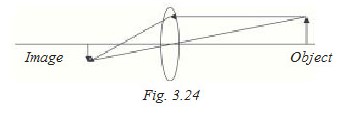
Quick test for lenses
To distinguish between positive and negative lens look at an object at a distance from the lens and move the lens gently. If the image also moves in the same direction (with motion) it is negative lens. If the image moves in the opposite direction (against motion) it is positive lens.
Prism power in lenses: Prentice rule
A spherical lens has prism power for every point in it except for the optic center, at which the prism power is zero. In plus lenses, the prism power bends light rays toward the optic axis, and in minus lenses, it bends away from the optical axis. Prism power increases with the distance of the point from the principal axis.
Using the principle of similar triangles it can be shown that the prism power corresponding to point A at a distance ‘y’ from the principal axis is the product of the lens power and the distance y. This is Prentice rule (Fig. 3.25).

This has application in designing the reading lens part of bifocal spectacle lens for patients with presbyopia. The prism effect helps in bending the rays up to avoid looking down through the reading lens and in reducing the convergence of the eye required for looking at close objects.
Decentration
Prism effect comes into play when the distance between the optic centres of the spectacle lens is not in line with the pupils of the patient. Looking through such spectacle lenses will cause discomfort.This is known as decentration.
Cylindrical lenses
Lenses in which one of the curved surfaces is cylindrical are known as cylindrical lenses. They are used in correcting astigmatism (Fig. 3.26).
A cylinder has no curvature in a direction parallel to its axis. So it has no refractive power in that direction. It is curved in the direction perpendicular to its axis and therefore has a refractive power. The refractive power of a cylindrical surface is also P = (n– 1) / r, as in the case of spherical surface, r being the radius of curvature of the cylinder. With a cylindrical lens one gets a focal line instead of a focal point.
Astigmatism arises when one of the patient’s eyes has different powers in different axes. The extra power needs to be added or subtracted in any required axis with the help of positive or negative cylindrical lens.
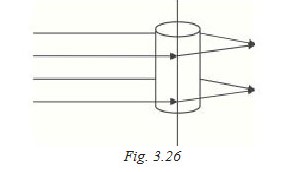
Other properties of light
Some of the other properties of light are as follows.They arise because of the wave nature of light.
Scattering
Particles of dust, moisture, scratches on mirror, lens and prism surfaces cause scattering (irregular reflection) of light. Scattering results in loss of brightness and glare.
Polarisation
Light waves are transverse in nature. The vibrations of electric field (or magnetic field) that constitute light are at right angles to the direction of propagation of light. Ordinary light is unpolarised and has vibrations in all directions. Unpolarised light under going polarisation has the vibration confined to one direction. Reflection of light (unpolarised) from some surfaces also gives rise to polarised light (Fig. 3.27).
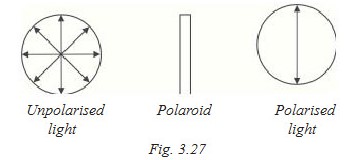
When polarised light is viewed through a polaroid there is variation in the brightness of light seen through it depending on its orientation. The light is even cut off in two orientations. This property of Polaroid to cut out strongly polarised reflected light is used in special sun glasses known as Polaroid glasses.
Vergence
This is a useful concept used by optometrists in their calculations (Fig. 3.28).
A parallel beam of light neither converges nor diverges. Its vergence is defined as zero.
A converging beam of light has positive vergence while a diverging beam has negative vergence. The vergence of a beam is measured in dioptre units. The vergence of a beam at a location is the reciprocal of the distance of the location in meter units from the point where the beam converges or appears to diverge.
A positive lens having a power + D introduces a positive vergence of D to a parallel beam of light while a negative lens of power – D introduces a negative vergence of D to a parallel beam of light.

Common refractive problems and correction
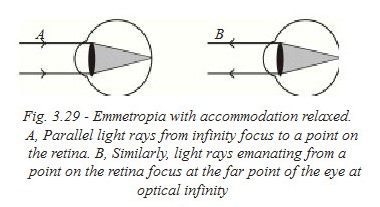
Emmetropia
Emmetropia is a normal refractive condition of the eye that parallel rays of light from a distant object are brought to focus on the retina without any accommodative strain resulting clear vision at all distances (Fig 3.29).
Ametropia
Ametropia is a abnormal refractive condition of the eye in which the light rays from infinity comes to a focus either in front or behind the retina without any accommodative effort. It may be classified as Myopia or short sightedness and Hypermetropia or long sightedness.
Myopia
Definition
Myopia is defined as that optical condition of the non accommodating eye in which parallel rays of light entering the eye are brought to a focus infront of the retina.
The uncorrected non accommodating myopic eye has some point at a finite distance beyond which objects will not be seen clearly. At this far point, an object will be in clear focus, but with increasing distances beyond it, the image becomes progressively more indistinct.
Eetiology of myopia
Myopia is of three types. They are:
a. Axial Myopia: It occurs due to the excessive axial length of the eye than normal.
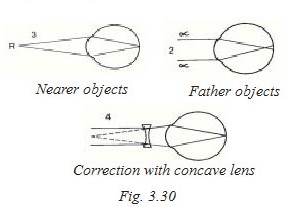
b. Curvature myopia: It is mainly due to the steepness of the cornea as well as lens curvature.
c. Index myopia: It occurs due to the increase of the refractive index of the crystalline lens usually in older age.
Management
Correction glasses, contact lenses and refractive surgeries are the treatment modalities available (Fig.3.30).Concave lenses are used to correct myopia.
Hypermetropia
Definition
It is a refractive error in which parallel rays of light are brought to focus some distance behind the sentient layer of the retina when the eye is at relaxed.
Etiology
-
- Axial - Physiological and Pathological
- Curvature
- Index
Optical condition
Parallel rays come to a focus behind the retina and the diffusion circles which are formed result in a blurred and indistinct image.
Types of hypermetropia
Total hypermetropia may be divided into
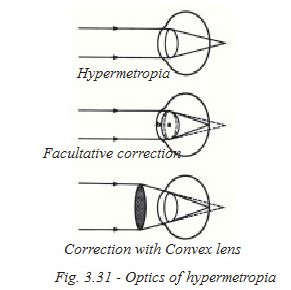
1. Latent hypermetropia - overcome physiologically by the tone of the ciliary muscle.
2. Manifest hypermetropia
- a. Facultative - overcome by accommodation
b. Absolute - cannot be overcome by accommodation
Natural course
- - At birth - 2-3 dioptre of hypermetropia
- It diminishes until after puberty the refraction tends to become emmetropic.
Clinical features
- 1. Blurring of vision for close work
2. Symptoms of eye strain
3. Convergent Squint
Management
Hypermetropia is corrected by using convex lenses
1. The general principle is that if the error is small,the visual acuity is normal and there is no eye strain or no squint, treatment is unnecessary.
2. In young children below the age of 6 or 7, some degree of hypermetropia is physiological and a correction need be given only if the error is high or if the strabismus is present. If the error is greater than 3 diopters, it is probably wise to advise that correcting lenses be worn constantly
In older children it is wise to base the correction on a subjective test carried out after cycloplegia has worn off.
Astigmatism
It is a refractive error where a point focus of light cannot be formed upon the retina.
Aetiology
1. Curvature astigmatism
2. Centering error of lens
3. Index Astigmatism
Symptoms
1. Reduction in visual acuity
2. Aesthenopia and eye strain are more when the error is small
3. Headache
4. Reflex nervous disturbances such as dizziness,neuroasthemia, irritability and fatigue.
Optical condition
Instead of a single focal point there are two focal lines. They are separated from each other by a focal interval.
Regular astigmatism
| 1. Simple - | Simple hypermetropia Simple myopic |
| 2. Compound - | Compound Hypermetropic Compound Myopic |
| 3. Mixed |
When the vertical curve is greater than the horizontal - it is called ‘with the rule astigmatism’ and the opposite condition is called ‘against the rule’ astigmatism.
Management
Cylindrical lenses are used in the correction of astigmatism
1. Spectacles
- - 0.5D or less with no decrease in vision and no asthenopia, no need to treat it.
- If there is decrease vision or aesthenopia correct it fully. If we don’t fully correct,any difference that is left to the patient to correct by his own efforts and if the patient is forced to do so, the symptoms of eye strain may continue or be exaggerated.
- In adults with high power who have never worn glass, the unaccustomed effect of cylinders of considerable power makes the object appear distorted and causes distress.So it is best to under correct first, until they become used to it when at a later date a full correction may be comfortable.
2. Contact lenses
3. Surgery: removing the sutures in the axis of more plus cylinder or putting extra sutures in the axis right angles to it.
4. Excimer - keratomileusis
- Treatment of irregular astigmatism is by
1. Contact lens 2. Keratoplasty
Presbyopia
Definition
As the age advances, it becomes more and more difficult to see near objects distinctly, that is the near point gradually receeds due to the loss of accommodative ability of the crystalline lens. It usually manifests around the age of 40.
Causes
- As the age advances lens become harder and less easily moulded so that the elastic force of the capsule is no longer greater than the resistance of the lens substance.
- Progressive increase in the size of the lens together with similar changes in the ciliary body reduces the circumlentral space, so that the zonule become slackened and works at a disadvantage.
Symptoms
- - A hypermetropic starts life with his near point considerably further away than that of an emmetropic so that the symptoms of presbyopia
will come earlier on.
- In a myope, the opposite condition holds, if he has an error of -4D, presbyopia will probably never occur.
- Small print becomes indistinct and in order to get within the limits of his recording near point,patient tend to hold his head back and his book well away.
- Sooner or later eye strain
- Headache.
Management
It is to provide the patient with convex lenses, so that his accommodation is reinforced and his near point brought within a normal working distance. A good practical hint is to make sure that with the reading correction patient is able to read the near vision chart not only at his reading distance but also some 12-15cm further away.
In some patients the cause of strain may be excessive convergence, in this case it can be relieved by using base in prisms or by decentering the lenses by a corresponding amount.
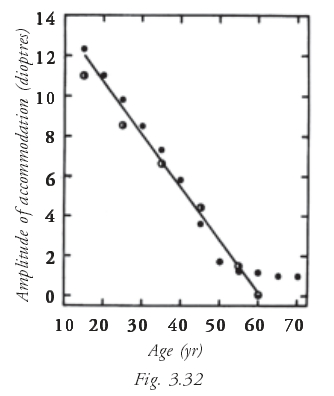
Lenses
This section deals with lenses, their types, their characteristics and designs. Classification has been made according to material and by how they are designed.
Corrective lens
A corrective lens is used to avoid or minimise the distortions through the edges of lens. In theory the Base Curve should have a same curvature, which coincides with the corneal curvature of the rotating eyeball, so as to maintain the proper vertex distance between cornea and the spectacles in all gazes and avoid distortions. Each manufacturer has an individualised series of base curves for toric meniscus lenses. Corrected lenses are in different designs but mainly in meniscus lens form which usually are ground on 6.00D Base curve.
A toric lens is curved like a meniscus lens but also contains a cylinder that formerly has been ground on a convex surface in single vision lenses and on a concave surface in bifocal lens.
Types of corrective lenses
Two principal types of eyeglass lenses are manufactured to correct vision: The corrective lenses are sphere, cylinder and combination of both sphere and cylinder and prisms. These corrective lenses are commonly given in either monofocal (single-vision lens) or multifocal (bifocal, trifocal and varifocal) forms.
Single-vision lenses, have the same power throughout a lens which corrects only one-either distance or near.
Multifocal lenses, combine two or more corrections in a single lens to provide sharp vision at more than one distance
As part of the process of refraction, the doctor decides which type of lens would most benefit a particular patient
Lens materials
Glass
Until recently, glass was the most commonly sold lens, mainly because it was cheaper and more resilient to scratches than plastic. All glass lenses do not scratch as easily as plastics lenses (even coated). However, it is much heavier and it also shatters on impact making it dangerous and unsuitable for dispensing to children and persons with an active lifestyle. It is very expensive for plastic lenses to be made photochromatic; hence glass is still in demand as a cheaper photochromatic option.
Common types of glass used are
- Crown glass (µ=1.523): It has a very hard surface – it is the hardest of all the spectacle lens materials and it has the highest Abbé number available in an ophthalmic lens (v=60) making it very clear.It is a soda lime- silica material that contains about 70% silica, 12% calcium oxide and 15% sodium oxide and some other materials in smaller percentages like potassium, borax, arsenic etc. It is extensively used for making single vision ophthalmic lenses and to make the main lens in a fused bifocal lens.
- Flint glass (µ=1.65 to 1.75, v=27 to 33): It is used for the reading area of fused bifocals. It is significantly softer than crown glass. Flint glass, material (1.620) is used in the making of bifocal or achromatic lens. It contains 60% lead oxide, 30% silica, 8% soda and potash and small percentage of arsenic. The lead oxide material increases the refractive index of glass as well as specific gravity and weight. This material is used for making the bifocal segment. It produces high chromatic aberration
- High index glass (µ=1.8 to 1.83, v= 25 to): The higher the refractive index of the material, the lesser curvature is required to be ground on the back surface of the lens to make the high power lens. Approximately the thickest lens has a refractive index of 1.5 and the thinnest lens has a refractive index of 1.9.When it compares to the conventional lens materials, a 1.60 refractive index lens is approximately 25% thinner than a thick lens and
- a 1.67 index lens is approx. 40% thinner
a 1.70 index lens is approx. 50% thinner
a 1.80 index lens is approx. 60% thinner
a 1.90 index lens is approx. 75% thinner
This is still preferred as the index is higher than the highest plastics index available. As the Abbe value decreases with increase in index it is important to coat hi-index lens with anti - reflection coatings.
Plastic
Plastic lenses have almost the same refractive index as glass, making them only very slightly thicker than glass. And they weigh only half as much as glass lenses and do not shatter easily – which makes them more comfortable and safer. However, plastic lenses are more prone to scratches and they become yellow over time. But this has been overcome today by enhancements in scratch-resistant coatings. Plastic lenses are available in almost all ranges as glass lenses and soare fast replacing glass in the spectacles industry.
Common types of plastic used are
- CR39 (Allyl diglycol carbonate) (µ=1.49 to 1.5,v =54 to 60): It has the lowest refractive index of any plastic material currently used as a spectacle lens. Thus it is suitable for smaller powers. The finished weight of the lenses is about half that of glass and they have a considerable mechanical strength advantage. However, as it is thicker,CR39 has never been popular for high corrections. Even uncoated CR39 can resist scratches to a good extent but it is easily scratched if misused. CR39 can be tinted easily and satisfactorily A.R. coated.
- Note: CR 39 was invented in the research work undertaken during the World War II. This was the 39th formula of the series of Columbia Resins (CR) produced for airplane fuel tanks by the Columbia Chemical Co. Hence, it is called CR 39.
- Polycarbonate (µ=1.586, v=28 to 30): This lens has phenomenal impact resistance that makes it almost “bullet-proof ". Hence it is highly suitable for safety eyewear – industrial and sportswear. It is very light and because it is non porous, tinting it is difficult. Today, polycarbonate lenses are dispensed for high myopes, as the lens is relatively thinner. Also, as it has a low Abbé value – it is recommended to dispense with Anti-reflective coating. When dropped from a height of about 1 inch above a countertop, polycarbonate lenses make a distinctive high- pitch sound. The sound is similar to that of dropping a poker chip in the same manner.
- Polymethlmethacrylate (PMMA) (µ=1.49,v=58): This is a tough plastic material used for lens manufacturing. With a center thickness of 3.0mm without special hardening process, the PMMA plastic lenses have a thicker profile than glass lenses, they scratch more easily and do not protect the eye from UV rays unless properly tinted.
Lens forms
This section discusses the different lens forms or the possible contours of the lens surface. Almost all spectacle lenses are meniscus lenses having - both convex and concave surfaces. Different lens forms have different benefits. For instance, curved lenses are often made flatter to improve the cosmetic appearance.
Single vision lenses
Single vision lenses have the same power or vision correction throughout the lens area. Single vision lens forms can be divided into the following basic categories (Fig. 3.33).

- Flat: If the lens form is flatter, the lens is thinner.Thus the best form of the lens to make it as thin as possible without making the centre too thin (for minus powers) is chosen.
- Lenticular: This lens form is used for high powers– usually more than 10DSph. This form reduces the thickness and weight of high-powered lenses, making them easier to fit. This is done by having only a small circular central area with the actual power. The periphery of the lens is mounted on a longer diameter, thin plano-carrier which is easily edged to fit into the frame (Fig. 3.34).

Here the high power lens is cemented onto a base lens. This is the only way that very high-powered lenses can be made. Blended lenticular lenses have the optical power zone blended with the periphery.Lenticular lenses are more conspicuous than blended lenses
Aspheric: An Aspheric lens is particularly designed to eliminate the peripheral distortions. It has a complex front surface that gradually changes the lens curvature from the center to periphery. In plus lenses,the front curvature of the lens flattens toward the edge of the lens. In minus lenses, the curve becomes steeper toward the lens edge. A conventional pattern lens may be optically correct through its center but causes a increased effect of the lens power as the patients vision moves away from the center to the edges of the lens.

Sometimes aspheric lens can cause reflections off the flatter back surface of the lens because it is positioned slightly closer to the face than conventional lenses. The special coating like AR coating may be a best option to control these reflections and also improves the quality of vision.
Multifocal lenses and design
For Presbyopes there are many lens forms that can cater to different functions and bring different benefits:
Bifocals
The lens has two distinct zones:for distant vision and for near vision. The near vision power is provided by adding or fusing a plus power lens to the distant vision power base lens. This reading segment can be designed in many ways, but it is always found at the bottom of the lens, converging towards the nasal side of the lens. In all bifocals the wearer experiences a “jump effect" when the eye travels from the distant vision zone to the segment – because of the difference in powers. Always warn first time bifocal wearers that they will have to adapt to the lens as there are two zones.
- Kryptok Bifocal: Here the reading segment is a small circle. Here the eye of the user has to travel to the centre of the segment to get the maximum reading area (Fig. 3.36).

- D-Bifocal:The reading segment is shaped like the letter D. This is only available in plastic lenses as it is very expensive to make it with glass. The advantage of a D segment over a kryptok segment is that the maximum reading area is reached at the top of the segment itself, which makes it more comfortable. In this lens, the “jump effect" is also reduced. These are the best form of bifocals that you can recommend (Fig. 3.37)
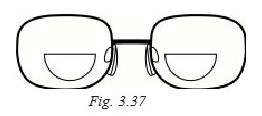
- Executive Bifocal:These bifocals have the entire bottom of the lens as the reading zone. This gives a larger reading area but the jump effect is very pronounced. This is usually recommended for those who do a lot of reading and writing.However, if a patient has been using executive lenses it is very difficult for him to adapt to other
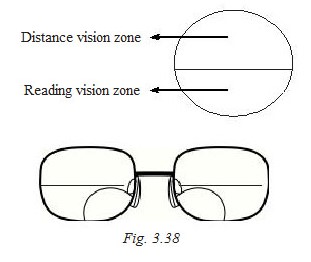

types of bifocals. Thus, these are not highly recommended.
- Trifocals: These lenses have three distinct power zones: distant, intermediate and near vision zones.This is not in use nowadays (Fig. 3.39)
- Varifocal lenses: Varifocal lenses also called Progressive Addition Lens are designed to give the closest resemblance to vision with a normal eye, as these are not distinctly divided into zones.Instead, they have the power increasing gradually from the distant to the near vision zone. There is absolutely no jump effect. The lens is more comfortable as powers are available for vision at any distance; and not only for fixed distances like > 6m and < 35cm as in bifocals. But the zone of vision is restricted and the peripheral areas by the lower side of the lens are slightly distorted. So, this lens also needs some adaptation time, as the wearer needs to adjust to viewing only along the viewing zone. Advise the patient to learn to tilt his head at different angles, to focus on objects
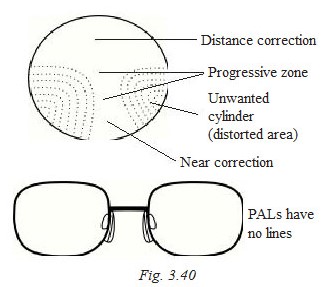
- at different distances. This lens is more comfortable and cosmetically more appealing as there is no distinct segment (Fig. 3.40).
- Progressive lenses have been developed over the years to increase adaptability, comfort and its flexibility to suit any frame. These lenses are broadly classified into the following types based on their design:
- Hard design PAL: Hard design lenses have a narrow progressive zone i.e., wider distortion areas with a little reading area.
- Soft design PAL: Hard designs have been improved to reduce the distorted area and increase the reading area. In soft design, the progressive zone is much wider that causes very minimal distortion to the wearer and gives an excellent reading area. These designs are very comfortable and easier to adapt to.
- Short corridor PAL: These lenses have a short intermediate corridor enabling the lens to be fitted into smaller frames.
While dispensing PAL lenses demonstrate the clarity of different viewing zones by having the patient focus on objects at different distances. Also, remind the patient that he will take a while to adapt to the lenses; and that he must learn to view only along the progression zone and not the distorted area – in order to view objects on the side he must turn his head instead of moving his eye alone (Fig. 3.41).
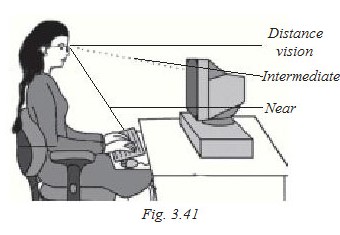
Transposition
Definition
It is a technical formula to change the lens form from one type to another. There are two types of transpositions, Simple and toric transposition.
Simple transpositions are used to convert one form to another, usually “+" to “-". Toric transposition is used to for meniscus and cylindrical lens manufacture.
Rules of simple transposition
- Algebric sum of sphere and cylinder is a new sphere.
- Cylindrical power is the same but
- Sign of the cylinder is reversed and axis of cylinder is changed by 900
Examples
- +2.5 D Sph / +3.0 D cyl x 150°
Answer
- New sphere = + 5.5 D Sph
- New Cylinder = 3.0 D cyl
- Cylinder power & axis = – cyl & (150-90)60°
- Final Rx : + 5.5D Sph / - 3.0D Cylx 60°
Another example
- - 5.5 D Sph / + 4.0D Cyl x 150°
Answer
- New sphere = - 1.5 D Sph
- New Cylinder = 4.0 D Cyl
- Cylinder power and axis = - Cyl & (15+90) 105 °
- Final Rx: = -1.5D Sph / -4 D Cyl x 105°
Why we do the simple transposition
Usually we change the lens ‘+’ form into ‘-’.to reduces the central thickness of lens. It also minimize the peripheral aberration, reduce weight and gives easy adaptation.
Toric transposition
Toric transposition is an application for selecting the proper tool in cylindrical lens surfacing form (e.g., Meniscal) of lens so that it is easy to make a good correcting lenses.
Rules
- Choose the proper base curve first.
- Do simple transposition if signs of base curve and cylinder are not same.
- To find out the spherical surface power, subtract the base curve from sphere.
- To find out the cylindrical surface power,
- Both spherical and cylindrical surface determines the lens power. The toric rules are written as a fraction, the numerator value is a spherical tool power and denominator consists of both the base curve and cylindrical require to provide the necessary combination.
- a. Fix the Base curve as a cylinder at right angle to the axis of cylinder.
b. Add the base curve to the cylinder with axis of the cylinder specified.
Example
+ 1.0 D Sph / + 2.0 D Cyl x 165* (-6.0 Base curve) Base curve = -6.0
Simple transposition (base curve and cylindrical power are not same)= + 3.0 D Sph / - 2.0D Cyl x 75*
Spherical surface power = + 3.0 – (-6.0) = + 9.0 D Sph.
Cylindrical surface power = - 6.0D Cyl x 165* -2.0 + (-6.0) = - 8.0D Cyl x 75*
Final Rx = + 9.0D Sph -6.0D Cyl x 165*/ - 8.0D Cyl x 75*
Another example
+1.0D Sph / +2.0D Cyl x 180* (+6 Base)
Base curve= +6.0
Simple transposition – not required
Spherical surface power = +1-(+6) = -5
Cylindrical surface power= +6 x900 +2+ (+6) = +8
Final Rx= - 5.0D Sph + 6.0D Cyl x 90* / + 8.0D Cyl x 180*
Points to remember
Transposition is applied only in optical surfacing lab.
- To choose the correct tool in lens surfacing.
- To bring the lens into proper curvature and thickness.
Measuring lens power
In optics, an ophthalmic lens is constructed so that its refractive power is constant at center of the lens rather than the edge of the lens. Lens power is usually measured by either a conventional method called hand neutralisation or the use of a lensometer.
Hand neutralisation by tial lens method
It is very simple and conventional procedure to neutralise the power of a lens with trial lenses. This method is being qualitatively followed by many practitioners (Fig. 3.42, Fig. 3.43)
Procedure
1.First checking of a lens often involves simply identifying if it is a sphere or cylinder in ‘+’ or ‘—‘ form lens.
2.Hand neutralisation is usually done by viewing a distant cross target through the lines whose limbs extend beyond the lens edge.
3.The lens is moved up and down, and left and right to ascertain the presence of a 'with' or and 'against' movement.
4.A 'with' movement is seen with minus powered lenses and an 'against' movement is seen with plus powered lens.
5.Movement is neutralised using an opposite power trial lenses. That is, a 'with' movement occur in concave lens is neutralised by placing the ‘+’ power trial lens in contact with the unknown power lens.
6.The power of the trial lens is increased until no movement of the cross hairs is seen.
7.If the unknown lens is spherical, the movement and speed will be in the same in both principal meridians.
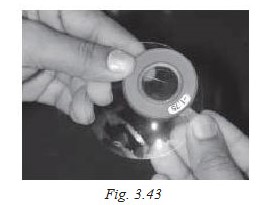
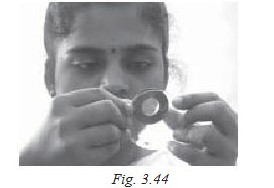
How to find out the cylindrical power
If the lens is cylindrical or sphero-cylindrical then every meridian needs to be neutralised one by one.
- To find the principal meridians hold the lens against the cross-hairs.
- Rotate the lens about it optical axis.
- At some positions, the appearance of cross-hairs through the lens will not be continuous with those outside the lens and will not be at right angles to each other.
- Rotate the lens so that the lines within the view of the lens are continuous with those outside the lens. This will constitute the principal meridians; these can be marked and individually neutralised. This will constitute the principal meridians; these can be marked and individually neutralised.
Lensometer and procedures
The lensometer is also known as Focimeter or a vertometer (Fig.3.45). The main use of the lensometer is to measure the back or front vertex power of a spectacle lens. The optical centre of the lens is located in order to position the lens correctly, relative to the visual axes and the centre of rotation. When the optical centre is positioned correctly in the lensometer, the sphere, cylinder and its axis and prism power can be measured. The power of the lens is measured by placing on the lens stop.

Procedure
Focusing the eyepiece
The eyepiece should be focused at each use as the setting will vary between individuals. Rotate the eyepiece until fully extended from the instrument (usually by rotating the eyepiece as far as possible in an anticlockwise direction). The graticule visible through the eyepiece will now appear blurred. The eyepiece should then be rotated in a clockwise direction until the target crosshairs and the graticule just come into focus. Continued rotation of the eyepiece will force the observer to accommodate in order to keep the graticule in focus. Accommodating whilst viewing the target can cause variability in the power measurement. With the power wheel at the zero position, the cross hairs and the target should be in clear focus. Failure to focus the eyepiece will result in incorrect readings of lens power.
Determining the lens power (Spherical lenses)
If all the lines or dots of the target are in focus at a given setting of the power wheel, the lens is spherical.
Marking the optical centre
- Check that the centre of the lens coincides with the centre of the target.
- When this is so, the lens is correctly positioned and the optical centre could be marked.
- While there is no centre dot, the whole set of dots can be ‘framed’ within the lines of the graticule to locate the centre.
- Repeat the same procedure for the other lens.
Determining the lens power (Sphero-cyllenses)
- Step 1 (finding the sphere power) Rotate the power wheel until one set of lines (stretched dots) becomes clear. Start with the higher positive power (or lower negative power). The axis drum will need to be rotated to ensure that the lines are unbroken.Note the power on the power wheel.
- Step 2 (finding the cyl power) Rotate the power wheel until the second set of lines (stretched dots) becomes clear. The second power reading minus the first reading will give the power of the cyl (and its correct sign).
- Step 3 (finding the axis) Note the direction of the lines (stretched dots) at the second reading. This is the axis. The rotatable line in the graticule is used to line up with the stretched dots to determine the axis.
Examples
- Step 1 (finding the sphere power) Rotate the power wheel until one set of target (lines or dots) becomes clear. Start with the higher plus power (or lower minus power). The axis drum will need to be rotated to ensure that the target is unbroken. Note the power on the power wheel. In this case the power reading is +2.00D.
- Step 2 (finding the cyl power) Rotate the power wheel until the second set of targets becomes clear. The second power reading minus the first reading will give the power of the cyl (and its correct sign). In this case the second reading is –1.00D. So the cylinder power is: -1.00 and + 2.00 becomes -3.00D.
- Step 3 (finding the axis) Note the direction of the lines at the second reading. This is the axis.The lines are lying at 90 degrees.
So the lens power prescription is +1.00/-2.00 X 90 degrees.
Determination of prism power with lensometer
The lens is correctly positioned with the optical centre on the lens stop. If the target is displaced either vertically or horizontally, then the prism is present in the lens.The direction of the displacement of the focimeter target indicates the base direction of the prism. Thus, if the target is displaced upwards from the centre of the crosshair, base up prism is present in the lens. The value of the prism is measured from the centre of the target to the centre of the eyepiece scale.
Conclusion
Accurate measurement of lens power and the location of the optical centres is an important part of the successful prescribing and dispensing of ophthalmic lenses.
Lens - special features and coatings
Lenses also come with additional features such as being photochromatic, tinted or coatings that bring more advantages such as glare control or scratch resistance. Some of these common features are discussed below (Fig. 3.46).
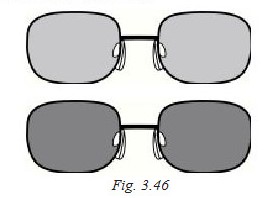
Tinting
This is usually done to reduce the transmission of light when protection from harsh lights is necessary. Thus, while tinted lenses protect from sunlight, they tend to be unsuitable for indoor lighting. Tint colours include: Pink, Blue, Yellow, Grey, Black,Brown, and Green. Tinting methods are of the following types:
- - Solid Tints: The tint is distributed (usually)evenly throughout the lens material. Thus even
if scratched the transmission is still blocked. This is important especially when viewing harmful
sources of light such as welding arcs. The drawbacks of solid tinted lenses are that a different
stock lens is needed for each colour and that the depth of tint depends on the lens thickness, hence
high prescriptions look odd – darker in the middle for plus lenses, darker at the edge for minus lenses.
- - Surface Tints: In glass lenses, this is applied by a vacuum coating process, in which the tint material is evaporated in a vacuum chamber then recondensed on the cooler lens surface. They are
normally on a single surface, so scratches allow transmission. Plastic lenses are tinted by immersing a clear lens into a bath of dye solution.The dye penetrates evenly, but not very deeply,
over the whole surface of the lens and a uniform tint is produced. Lenses can also be tinted in a
gradient – with one end darker and fading out towards the other end.
- - Tinting in high power lenses: Usually the tinting is done either with lens itself or on surface of the lens. In high power lenses tinting gives uneven
colouring across the lens. The ‘+’ lens, absorbs more tint at centre and the ‘-’ lens peripheral part absorbs more tint at the periphery. Tinted power
lenses are not advisable because it reduces the actual illumination, disturbs the clear vision at near, decrease the functional vision especially in
high-powers and ultimately may cause poor cosmetic appearance to the wearers.
Photochromatic lenses
These are used to protect from sunlight and UV rays. These lenses are clear in the shade and indoors and darken when exposed to UV/sunlight. These lenses are ideal for spectacle wearers who need to work outdoors. This effect is brought about by Silver Halide, which is transparent. On exposure to light, this breaks down to silver + halogen. The silver is opaque and hence the lens darkens. Earlier these lenses reacted only to UV light and only at low temperatures, but this problem has been overcome. Photochromatic lenses can be made from glass as well as plastic. Although they totally block UV rays, the darkening performance of plastic is not as good as glass. Also, the life of the current plastic photochromatic materials may also be limited. Photochromatic dyes are solid tinted in glass and surface tinted in plastics. Photochromatic lenses are available in Photo-Grey,Photo-Brown and Photo-Green tints. Some fancy lenses are also available in other colours such as blue and pink (Fig. 3.47).

Scratch resistant coating (SRC)
All plastics lenses need to have scratch resistant coatings as they are relatively soft and easily scratched in comparison with glass. As many of the higher index plastics have a softer surface than CR39, a hard coating is a must. Hard coatings can be applied by the following methods: dipping the finished lens, spin-coating, along with the lens as it is being cast, or by vacuum coating. An AR coat increases the surface hardness of a plastic lens to some extent
Anti-reflection coating (ARC)
At any lens surface, some light is lost by reflection.Artificial powerful lights (i.e.) halogen lights in cars and trucks and computer monitors can cause reflections in uncoated lenses. When light passes through spectacles some light rays are reflected by front and back surface of the lens producing ghost images. From 4% (normal index) to 9% (high index) of the incident light is lost. AR coatings reduce this loss by increasing the transmission, up to 99%. Some lens suppliers only coat one surface, this is not very effective. Both surfaces should always be coated. The colour of an AR coat is seen in reflected light, therefore the coat looks green or blue. AR coating is now given as a multi coat along with hard coat. Multilayer coats increase transmission for different wavelengths of light. Once a lens has been AR coated, it is difficult to apply any other surface coatings. AR coatings enhance the quality of vision by cutting down the glare induced by lens wearing and also improve the looks of the wearer as the reflections on the front surface of the lens are reduced and the wearer’s eyes are clearly seen. AR coated lens should be cleaned with proper special cleaning solutions. AR coated lenses are readily available in market and it can be coated separately too.
Water repellent (hydrophobic) coating
This coating is especially useful for those who frequently go between hot and cold environments,as it does not allow moisture to stay on its surface. This also makes cleaning much easier. Most AR coated lenses have hydrophobic coats.
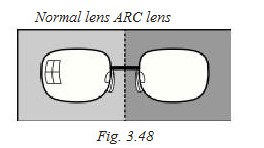
Polarising lenses
Here a polarising film is placed between two layers of CR39 or glass. Polarising lenses are always grey without additional tinting. They eliminate 99.9% of glare from horizontal surfaces: roads, water and snow. They also improve vision and comfort, provide 100% UV protection and are ideal for driving. These are available in single vision, photochromatic, bifocal and progressive type lenses.
Other corrective methods
Contact lenses
These are thin plastic wafers which are designed to rest over the cornea or sclera to correct refractive errors. Leonardo de Vinci is known as the “Father of Contact Lenses". Contact lenses are classified into the following types based on the type of material that they are made of:
- Hard Contact Lens: These are usually made of PMMA (Poly methyl-methacrylate) and so have minimal flexibility. The recommended wearing schedule for these is 8 to 10 hours a day. These are ideal for patients with keratoconus and those with high astigmatism.
- Semi-soft Contact Lens: These are usually made of CAB (Cellulose acetyl butyrate) or Fluorosilicon. The flexibility is moderate. The recommended wearing schedule for these is 8 to 10 hours a day.
- Soft Contact Lens: These are usually made of HEMA (Hydroxyl ethyl metha acrylate) and have good flexibility. The recommended wearing schedule for these is 10 to12 hours a day. But this can provide correction for astigmatism less than 1.25 DCyl only. The types of soft contacts are
- - Cosmetic: Regular and color lenses
- Prosthetic: for corneal opacity; used by patients with Leucoderma
- Therapeutic: Used as treatment for conditions like Bullous Keratopathy
- Toric: For Astigmatic correction in the range up to -6 DSph and -3.25 DCyl
The following are indications for use of contact lenses
- All refractive errors
- Anisometropia
- Anisokonia
- Unilateral aphakia
- Keratoconus
- Corneal opacity
- Aniridia
- Nystagmus with refractive error
Contact lenses SHOULD NOT be used if the following contra indications are noticed
- Any inflammatory conditions in the eye
- Dry eye
- Allergies
- Pregnant women
- Uncontrolled Diabetes
Contact lenses have the following advantages over spectacles
- Field of vision is high
- Cosmetically better
- No Diplopia
- No peripheral aberrations
- No chromatic aberrations
- Sharp vision
However, these disadvantages are noticed with contact lenses:
- Old patients may have a lack of dexterity and thus handling contacts becomes difficult
- Wearers have a foreign body sensation
- Contacts are easy to lose and lens spoilage is high due to breakage, dislodgement etc; this can lead to high recurrent expenditure
- They can cause corneal complications like erosions, ulceration, edema, vascularisation
- Spectacles are anyway required for reading (or distance vision) in presbyopes
Fitting techniques
- The diameter of soft contact lens should be 1.5mm more than the limbus
-The base curve of soft contact lens should be 1.25 mm flatter then the flattest keratometric value
- It should have equal coverage in all meridians and should have ideal movement of at least 1mm
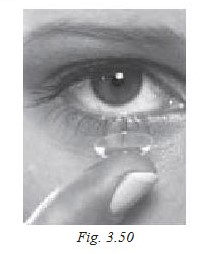
- Ideally the diameter of semi-soft and hard contact lens should be less than the cornea
- The fitting of semi-soft and hard contact lens is entirely based on keratomery value
- But for the selection of first trial lens, the base curve must fall on the mean keratometric value
- Fluorescein pattern can be studied for fitting evaluation
The following guidelines should be explained to the contact lens wearer:
- Hands should always be washed with soap beforehandling contact lenses
- Contact lenses should be used for more than 10 hours at a stretch
- Contact lenses should be removed while sleeping
- Store the lens in the given lens case when not in use. Fill the case with the solution till the lenses
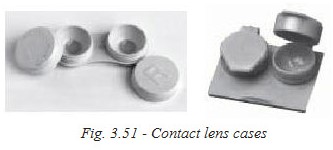
- are submerged. Remember to store the correct lens (right/left) in the correct cup
- Cosmetics should be applied only after insertion of contact lenses
- Lenses should be cleaned regularly with the prescribed solution
- Rinse both sides of the lens by rubbing it well

- Soak the lens for a minimum of 6 hours in the solution. This helps in cleaning, disinfecting,protein removal and conditioning of the lens
- Never clean the lens with tap water
- An ophthalmologist should be consulted when any irritation is felt in the eyes
Low vision aids
When visual impairment cannot be corrected by spectacles, medicine or surgery, low vision aids are an alternative. Many people around the world with permanent visual impairment have some residual vision which can be used with the help of low vision aids. Those with low vision often exhibit the following signs:
- Difficulty in recognizing a familiar face
- Difficulty in reading - print appears broken,distorted or incomplete
- Difficulty in seeing objects and potential hazards such as steps, walls, uneven surfaces and furniture
Magnification and types
There are several ways in which an image can be enlarged for viewing by a low vision patient:
- Optical magnification: Magnifying the object by means of a lens or combination of lenses like magnifiers and telescopes
- Relative Size Magnification: Increasing the size of the real object, for example large print books or televisions with larger screen size
- Relative Distance Magnification: Reducing the distance of the object, for example, moving the reading material closer to the eye or going closer to the writing board
- Linear magnification: The linear magnification or transverse magnification means the images projected on a screen in a linear dimension. The image size corresponds to the size of the object creating it.
Traditionally the power of low vision devices is denoted as ‘x’, which means the relative increase in the image size to the object size. Each ‘X’ represents four dioptrical powers (4D). For example a 2x (equivalent of that provided by 8D) would mean an increase in the image size by two times. As different manufacturers use different methods to calculate this, there is a growing trend to move away from this labelling and today, the powers of magnifiers is denoted in dioptres or as equivalent viewing distances (EVD).
Magnifiers
Magnifiers are lenses that enlarge images. These are usually used for desk work. They come in the following models for specific activities:
- hand-held magnifiers
- hanging magnifiers
- stand magnifiers
- illuminated hand-held/stand magnifiers
- spectacles magnifiers
- bar magnifiers
- dome magnifiers
A lower power magnifier, though it has a larger diameter or field of view, will only create a smaller image. A higher power magnifier will have a narrower field of view but the image will be larger.
Spectacle magnifiers are the most commonly prescribed magnifiers. They are used for binocular viewing. Hand held magnifiers are used commonly for reading. They come with in-built illumination for increased contrast and clarity


Telescopes
A telescope magnifies the image at all distance.Telescopes are basically constructed based on the Galilean and Kaplerian principle. It is available in the ranges of magnification from 2x to 12x. Nowadays,the modern telescopes are available which automatically focus according to the user’s distance. The telescopes are practically not comfortable for prolonged use but it may be best in static situations i.e., watching TV, and seeing the blackboard in classrooms. Telescopes may be attached to prescription eyewear to create what is called a bioptic system. Bioptic eyewear design has evolved from large telescopic tubes to smaller, more cosmetic telescopes. These are prescribed for distance and intermediate vision. Types of telescope include:
- Hand-held
- Clip-on
- Spectacle mounted
- Bioptic designs
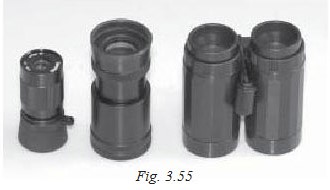
Glare control devices
As glare may be a significant disabling factor in many eye conditions, tinted lenses are routinely prescribed. Tinted lenses are absorptive filters, which are used to reduce glare prescribed to improve the functional vision by reducing glare and light sensitivity and increasing the contrast. Different tints are available which offer various levels of absorption and different cut-off points for the visible spectrum of light according to the patient’s specific need. As glare and photophobia may be a significant disabling factor in many eye conditions; it is also recommended along with caps and visors.
Closed circuit television (CCTV)
Magnification from telescopes, magnifiers and microscopic lenses is limited by their design, and can rarely be used successfully above magnification of 20X. Closed circuit television systems are capable of higher levels of magnification and can manipulate the brightness and contrast of the image.
In a CCTV system, a video camera is used in real time to capture the image of the reading material and display it on a monitor. For example, the poor

contrast of newspaper print can be enlarged 40X, but it can simultaneously be converted to white letters on a black background. The advantage of a CCTV is in its greater amplitude of magnification of 3x to 100x, normal working distance and reversed polarity (e.g. white on black). However CCTV's can also be used for writing, cutting fingernails and other such minute near tasks. CCTV's have a range of magnification and are made in either black and white,or in color. There are three different kinds of CCTV's, each offering its own advantages:
- Free-standing Units: These units consist of a monitor on top of a flat platform. The user places the material to be read on the platform and moves the platform around to read. The magnification can be adjusted.
- Portable CCTV's: Portable CCTV's can be plugged into any television. A device about the size of a computer mouse is rolled across the material to be read and the magnified image appears on the TV.
- Truly Portable CCTV's: These units use the same mouse-like device, but the image appears not on a TV but in a pair of goggles one wears.
The disadvantages are the cost and the bulk of the common free-standing CCTV that makes it quite immovable
Non-optical low vision devices
Non-optical devices are items designed to promote independent living for the visually impaired individual. These improve environmental perception

through enhancing illumination, contrast and spatial relationships. Devices include illumination devices,writing guides, bold-lined paper, needle-threaders, magnifying mirrors, high contrast watches, and large print items.
Other non-optical devices include talking watches, talking calculators, large print books and Speech and Braille conversion systems. With further developments in electronics, more devices are becoming available for people with low vision
Student exercise
Choose the correct answer
a. Gold c. Silver
b. Nickel d. Platinum
a. Flexible c. Have low melting points
b. Brittle d. Not reusable
a. Distance between c. Horizontal length of the lenses eyewire
b. Length of the d. Effective Diameter temple
a. Cable bow c. Skull
b. Convertible d. Library
a. Aluminum c. Titanium
b. Nickel d. Monel
a. Sportswear c. Reading glasses
b. Distance only d. Children
a. Cellulose acetate c. Optyl
b. Polycarbonate d. Carbon fibre
a. A part of the frame c. Attached with a clip
b. Attached with a screw d. Stuck to the frame
a. Temple c. Eye wire
b. Bridge d. Hinge
a. Injection moulding c. Electroplating
b. Riveting d. Routing
Lenses
a. Lighter c. Thinner
b. Shows less dispersion of light d. Cheaper
a. Metres c. Dioptres
b. Centimetres d. No unit
a. Trifocals c. Plastic lenses
b. Executive Bifocals d. Progressive addition lenses
a. Plastic c. Both have same thickness
b. Glass d. Both cannot have same power
a. Kryptok bifocals c. D Bifocal
b. Trifocals d. Progressive lens
a. Frame’s horizontal axis c. Pupil of the patient
b. Geometric centre of the lens d. Lower eyelid
a. Use plastic frames c. Add photochromatic coating
b. By tinting d. Add Anti-reflection coating
a. Refractive index c. Abbe value
b. Focal power d. Volts
a. Tinted lens c. Bifocals
b. Photochromatic lens d. Polarized lens
a. Progressive lens c. Hi index lens
b. D Bifocal d. Executive Bifocal
Other corrective methods
a. Cheaper c. Easier to handle
b. Offering better field of vision d. Easier to maintain
a. Cleansing c. Lens conditioning
b. Protein removal d. Preserving the power
a. Viewing distant objects
b. Making a large image appear smaller
c. Making near objects appear larger
d. Increasing field of vision
